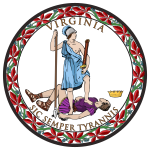| ||||||||||||||||||||||||||
| ||||||||||||||||||||||||||
 County Results
| ||||||||||||||||||||||||||
| ||||||||||||||||||||||||||
| Elections in Virginia |
|---|
 |
The 1924 United States presidential election in Virginia took place on November 4, 1924. Voters chose 12 representatives, or electors to the Electoral College, who voted for president and vice president.
The 1900s had seen Virginia, like all former Confederate States, almost completely disenfranchise its black and poor white populations through the use of a cumulative poll tax and literacy tests.[1] So severe was the disenfranchising effect of the new 1902 Constitution that the electorate for the 1904 presidential election was halved compared to that of previous elections, and it has been calculated that a third of those who voted were state employees and officeholders.[1]
This limited electorate meant Virginian politics was controlled by political machines based in Southside Virginia — firstly one led by Thomas Staples Martin and after he died the Byrd Organization. Progressive “antiorganization” factions were rendered impotent by the inability of almost all their potential electorate to vote.[2] Unlike the Deep South, historical fusion with the “Readjuster” Democrats,[3] defection of substantial proportions of the Northeast-aligned white electorate of the Shenandoah Valley and Southwest Virginia over free silver,[4] and an early move towards a “lily white” Jim Crow party[3] meant that in general elections the Republicans retained around one-third of the small statewide electorate,[5] with the majority of GOP support located in the western part of the state. However, in many areas — like in Tennessee during the same era — the parties avoided competition by an agreed division over local offices.[2]
Virginia was less affected than Oklahoma, Tennessee or North Carolina by the upheavals of World War I and the Nineteenth Amendment, although there was an unsuccessful challenge to lily-white control of the state’s Republican Party in 1921.[3]
During the prolonged national convention, Virginia delegates supported favorite son Senator Carter Glass, who had virtually no support elsewhere.[6] Ultimately the nomination went to a compromise candidate in Wall Street lawyer and former United States Ambassador to the United Kingdom John W. Davis of West Virginia. Although West Virginia was a border state whose limited African-American population had not been disenfranchised,[7] Davis did share the extreme social conservatism of Southern Democrats of his era; he supported poll taxes and opposed women's suffrage.[8] In addition, Davis, like Coolidge, favored strictly limited government.[8][9] At the same time a progressive third-party run was predicted as early as winter 1923–24, and ultimately Wisconsin Senator Robert M. La Follette Sr. would be nominated by the “Committee for Progressive Political Action”.[10]
Neither Davis, La Follette, nor Republican nominee, incumbent President Calvin Coolidge campaigned in the state, which was always viewed as certain to go for Davis after having voted Democratic at every election since 1876. A Digest poll at the end of October, which included votes for some candidates not on the ballot, had Davis winning by 22.5 percentage points,[11] a figure which understated his final margin of 29.69 points or a 6.22-point improvement from James M. Cox in 1920. Progressive Party candidate La Follette would relegate Davis to third in twelve states and carry his home state of Wisconsin, but had very little appeal amongst Virginia’s restricted electorate, reaching double digits in only four counties and six independent cities. Overall Virginia was La Follette’s sixth-weakest state[a] after South Carolina, North Carolina, Mississippi, Tennessee and Rhode Island.
Until 2016, this was the last presidential election where a Democrat carried Virginia without winning the presidency, and remains the last time that a Democrat who lost the popular vote has carried the state.
- ^ a b Kousser, J. Morgan. The Shaping of Southern Politics: Suffrage Restriction and the Establishment of the One-Party South, 1880-1910. Yale University Press. pp. 178–181. ISBN 0-300-01696-4.
- ^ a b Key, Valdimer Orlando (1949). Southern Politics in State and Nation. pp. 20–25.
- ^ a b c Heersink, Boris; Jenkins, Jeffrey A. Republican Party Politics and the American South, 1865-1968. pp. 217–221. ISBN 1107158435.
- ^ Moger, Allen. "The Rift in Virginia Democracy in 1896". The Journal of Southern History. 4 (3): 295–317.
- ^ Phillips, Kevin P.; The Emerging Republican Majority, pp. 210, 242 ISBN 978-0-691-16324-6
- ^ "How the States Voted in Convention". York Daily Record. York, Pennsylvania. July 7, 1924. p. 10.
- ^ Ranney, Joseph A. In the Wake of Slavery: Civil War, Civil Rights, and the Reconstruction of Southern Law. p. 141. ISBN 0275989720.
- ^ a b Newman, Roger K. The Yale Biographical Dictionary of American Law. p. 153. ISBN 0300113005.
- ^ "The humility of 1924 presidential nominees offers path to more optimistic future". Carolina Journal. Retrieved February 1, 2022.
- ^ Richardson, Danny G. Others: "Fighting Bob" La Follette and the Progressive Movement: Third-Party Politics in the 1920s. pp. 180–183. ISBN 0595481264.
- ^ "Total on Digest Poll Gives Coolidge Victory: Concession of All States Where Straw Vote Was Close Still Leaves Him 327 Electors". Boston Daily Globe. Boston. October 31, 1924. p. 13.
Cite error: There are <ref group=lower-alpha> tags or {{efn}} templates on this page, but the references will not show without a {{reflist|group=lower-alpha}} template or {{notelist}} template (see the help page).
© MMXXIII Rich X Search. We shall prevail. All rights reserved. Rich X Search


